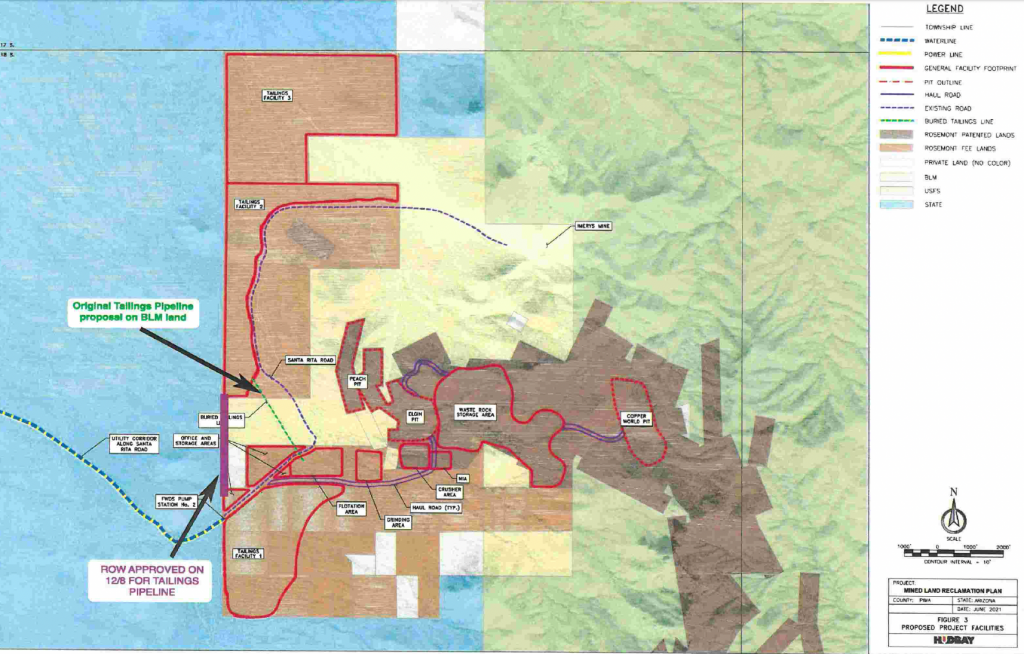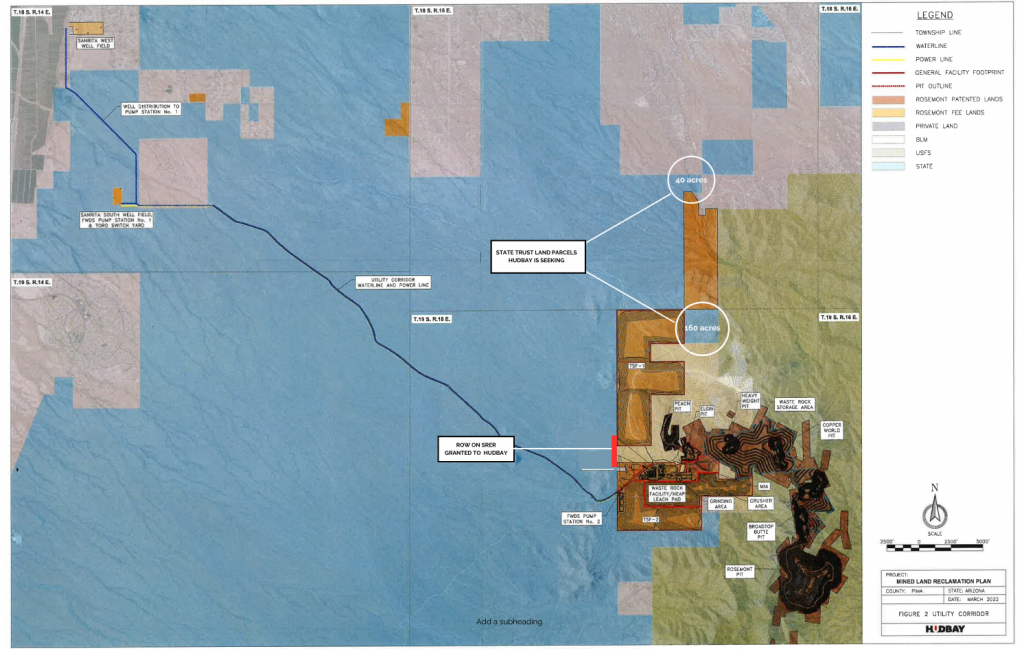Hudbay’s plans to construct the Rosemont Mine on the east side of the Santa Rita Mountains were thwarted by federal court decisions in 2019 and 2022 that essentially blocked the company from dumping mine waste on more than 2,500 acres of the Coronado National Forest. The company then developed a new mining plan to dump mine waste rock and toxic mine tailings – which is finely ground toxic waste created during the processing of copper ore — on the mountain’s west side.
But there was one major problem.
The company didn’t have sufficient land on the mountain’s west side, and what it had acquired was bisected by U.S. Bureau of Land Management property. The company initially planned to install an underground mine tailings pipeline across about a half-mile of BLM land to connect its mine processing operations with a tailings dump, according to Hudbay’s May 2022 Mined Land Reclamation Plan approved by the Arizona State Mine Inspector.
But this was a high-risk option for Hudbay because it would involve federal approvals.
Copper tailings often contain arsenic, lead, cadmium, and uranium among other metals. There is a long history of environmental contamination from ruptured tailings pipelines and leaking tailings dumps at U.S. copper mines, according to Earthworks, a Washington, D.C. based environmental group that monitors hard rock mining across the United States.
Hudbay had just been blocked by federal laws on the east side of the mountain and wanted to avoid seeking BLM approval for its tailings pipelines that could have resulted in a lengthy permitting process. The state land department provided an option that would allow Hudbay to avoid environmental review of its tailings pipelines.
By Sept. 1, 2022, Hudbay had submitted a proposed right-of-way to the land department for the “installation and maintenance of an access road, fresh water pipeline, tailings pipeline, process water return pipeline, electrical services and telecommunications on State Trust Land,” according to department records.
On Nov. 21, 2022, land department rights-of-way manager Michael Romero signed a right-of-way recommendation to be approved at the Dec. 8, 2022 Board of Appeals meeting, but made no reference to the tailings pipeline. The 30-year right-of-way would cost Hudbay $64,000.
A week later, Hudbay’s land manager Robin Barnes sent a Nov. 28, 2022 email to Romero expressing concern over the right-of-way recommendation not including reference to the tailings pipeline.
“The description does not match the current projected use of the right of way. Our application provides for 3 above-ground pipelines and we expect to have 3 above-ground pipelines for tailings, sand, reclaimed water and other uses,” Barnes’ email states. “Do these need to be included in the recommendations to the board?”
Romero replied a few minutes later: “No, the board only reviews the value. I can change the description in our system.” Barnes then asked if the department would provide Hudbay a copy of the right-of-way for its review before it was finalized by the land commissioner.
The Board of Appeals Dec. 8, 2022 agenda and public notice concerning the Hudbay’s right-of-way application, which was submitted under the company’s Arizona subsidiary Rosemont Copper Company, only referenced an “(a)ccess Road; OH 138kV electric transmission line; one 24-count fiber optic communication line; two above ground 24″ water transmission lines(.)”
The board quickly approved the right-of-way within the first 10 minutes of the meeting, which led to Barnes’ “super huge” email thanking Romero.
A week later, Barnes sent a word document to Romero that provided redlined edits to the right-of-way terms requesting the department to delete reference to the words “water transmission” and increase the number of pipelines from two to six.
Rather than sending Hudbay’s request to change the terms of the right-of-way back to the Board of Appeals for approval, which would have required a second public meeting and notice to the public, records indicate the department staff did what Romero told Barnes earlier he could do and changed the number of pipelines and deleted “water transmission” from the right-of-way’s terms and conditions.
The department did not immediately issue the revised right-of-way, which greatly worried Barnes who was “very concerned” it would not be approved before then Land Department Commissioner Lisa Atkins left office with the outgoing administration of Republican Governor Doug Ducey, Barnes stated in a Jan. 3, 2023 email to Romero.
By Tuesday, Jan. 18, 2023, the land commissioner still had not approved the right-of-way. “Is there anything we can do to move this forward?” Barnes asked Romero in an email.
It’s unclear when Atkins left office, but press reports indicate Robyn Sahid was appointed as the new commissioner by newly elected Democratic Governor Katie Hobbs in early January and assumed control of the office the week of January 23.
Hudbay later stated in an April press release that it had acquired the right-of-way in January: “In January 2023, Hudbay received an approved right-of-way from the Arizona State Land Department that will allow for infrastructure, such as roads, pipelines and powerlines, to connect between the properties in the company’s private land package at Copper World.”
The path of the 2,200-foot right-of-way across the Santa Rita Experimental Range abuts the BLM land, providing Hudbay with an easy, low-cost alternative to constructing underground tailings pipelines through federal property.

The Santa Rita Experimental Range (SRER) is in blue. The state Land Department right-of-way across SRER land is purple. The green dotted line is the underground tailings pipeline through U.S. Bureau of Land Management property, which is yellow. The brown “F” shaped parcel is private land owned by Hudbay that is a proposed tailings waste dump.
Save the Scenic Santa Ritas first leaned about tailings pipelines being discussed for inclusion in the right-of-way last April when the land department released public records that had been requested four months earlier. The department has since refused to comply with additional records requests submitted under the state public records law by the conservation group last April and June.
Among the records the department is refusing to release is the final approved right-of-way issued to Hudbay. The opaque circumstances related to the issuance of the right-of-way appear to have violated the State Open Meeting Law, according to a May 1 letter delivered to Commissioner Sahid from Gammage & Burnham, one of the state’s top land development law firms.
“We think there is a clear failure of public notice and a likely violation of the Open Meeting Law here,” stated Phoenix attorney Grady Gammage Jr. “As you know, actions taken in violation of the Open Meeting Law are void.”
The state has not responded to the Gammage letter, and there is no indication that the department intends to revoke the right-of-way.
“We urge Governor Hobbs to direct the land department to revoke the right-of-way that appears to include tailings pipelines that at the very least violates the spirit of the Open Meeting Law,” says Rob Peters, Executive Director of Save and Scenic Santa Ritas.
“The state’s backdoor deal conducted under the Ducey Administration and now being facilitated by the Hobbs Administration allows Hudbay to avoid federal scrutiny of the serious environmental threats posed by mine tailings pipelines that have a long history of failing and should be subject to vigorous environmental review.”
Hudbay is now seeking more benefits from the land department.
At Hudbay’s request, the department is preparing to auction 200 acres of State Trust Land adjacent to the Santa Rita Experimental Range. According to state records, Hudbay wants the land to potentially be used for mine tailings dumps.
The department’s Board of Appeals last July approved Hudbay’s request for the department to auction two non-contiguous parcels (40 acres and 160 acres) of State Trust Land located south of Corona de Tucson and immediately east of the experimental range. The department has not set an auction date as of Nov. 10.

Hudbay has requested the 40-acre and 160-acre parcels be sold at auction. Hudbay intends to use the “F” parcel as a tailings dump. Hudbay also owns the brown strip of property to the upper right of the “F” parcel. The 160-acre State Trust Land parcel would connect the “F” parcel waste dump with the narrow strip of land directly north, allowing Hudbay to expand its tailings waste dumps.
Save the Scenic Santa Ritas has sent letters to the land department and Gov. Hobbs opposing the issuance of the tailings right-of-way and the pending auction. Neither have provided a substantive response.
“The land department has conducted no environmental studies to determine the extent of the mine’s potential damage to the Santa Rita Experimental Range and regional groundwater depletion that will occur as a result of the department facilitating construction of this project,” Peters says.
The 53,000-acre Santa Rita Experimental Range is one of the country’s most important state-owned conservation areas. The range is legally required (See page 208-209) to be operated for “ecological and rangeland research” purposes and is managed by the University of Arizona. The range is part of the National Ecological Observatory Network (NEON), a continental-scale observation facility operated by Battelle and designed to collect long-term open-access ecological data to better understand how U.S. ecosystems are changing.
Hudbay’s mine processing operations will be constructed next to the range, and waste from the mine will create at least two separate 500-foot-high waste dumps holding millions of tons of toxic mine tailings along the eastern border of the range.
In addition to the tailings pipelines right-of-way, the land department in 2017 granted multiple rights-of-way across the range to Hudbay for an overhead high voltage power line, an underground water pipeline that will connect Hudbay’s well fields next to the Santa Cruz River to the mine site, an access road and an underground data transmission line and service road. The infrastructure will span approximately 11 miles of the range.
The mine will require continuous heavy truck traffic 24 hours a day, seven days a week, moving hazardous chemicals, including sulfuric acid, across the unpaved Santa Rita Road that bisects the experimental range before intersecting with Sahuarita Road. Mine traffic is expected to continue west to Interstate 19. No known traffic studies have determined the impact of Hudbay’s trucks on the range, the town of Sahuarita, Sahuarita Road, unincorporated residential areas, and the Interstate 19 interchange.
A 2017 federal environmental study conducted for the Rosemont Mine stated there would be between 100 and 120 round-trips per day of heavy truck traffic that would have used State Route 83 to access operations that were then planned for the east of the mountain adjacent to the Rosemont pit. There has been no similar study conducted for traffic that will now access the mine site from the west because Hudbay is operating only on private land.
Hudbay plans to construct a $1.3 billion mining plant to process at least 60,000 tons per day of copper ore extracted from three pits on the mountain’s west side and the Rosemont pit on the east side. The raw copper concentrate produced by the mine will be exported for at least the first four years of the 20-year mine plan, according to Hudbay’s Pre-Feasibility Study released in September.
According to company reports, the mine will use between 6,000 acre-feet and 13,000 acre-feet of water per year, depending on the facility’s final design. (An acre-foot is 325,581 gallons.) This is enough water to supply the annual needs of 21,000 to 46,000 households. Hudbay will pump the groundwater from two well fields near the Santa Cruz River. A loophole in state groundwater management laws allows mining companies to pump unlimited amounts of groundwater.

3 Responses to After making a secret right-of-way deal, the State Land Department is poised to auction land for Copper World’s waste dumps